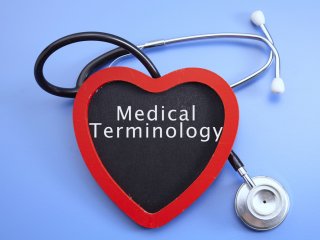
- Description
- Objectives
- Outline
- Materials
- System Requirements
Medical terms can be complex, confusing and difficult to memorize. By understanding the origins of the words and their building blocks - such as roots, prefixes and suffixes, the terminology will make sense and be easier to use in everyday settings such as doctor’s offices, labs, pharmacies, hospitals and clinics. This course is structured to help you break down commonly used terms and understand how medical terminology relates to body parts, diseases and procedures.
After completing this course, you should be able to:
- Identify the foundation of medical terminology
- List functions of major body systems such as skeletal, muscular and sensory
- Recall how your blood vessels, lymph nodes and heart work together
- Recognize the fundamentals of the body’s endocrine system, central nervous system and the male and female reproductive systems
Medical Terminology: An Overview Module 1
Prefixes, Roots, and Suffixes
Module one will take a look at the basics of body anatomy and organization, the foundation of medical terminology and why words are structured the way they are. We will look at the relationship between Greek and Latin roots, prefixes, suffixes and everyday pronunciation.
- History of Medical Terminology
- Applying Different Rules of Pluralization
- Deconstructing Medical Words
- Pronunciation and Everyday Usage
- Organization of the Body
Medical Terminology: An Overview Module 2
Bones, Muscles, Skin and Sensory
Module two discusses the major body systems such as skeletal, muscular and sensory and their root terminology. We will cover how systems function together and how they correlate to the overall health of the human body, as well as pathology, diseases and conditions that affect these systems.
- Terminology of the Skeletal, Muscular, Integumentary and Sensory Systems
- Skeletal Diseases and Pathology
- Classes and Types of Muscles
- Skin Layers and Conditions
- Anatomy of Eyes, Ears and Nose
Medical Terminology: An Overview Module 3
Heart, Lungs and Gastrointestinal
Module three covers how your blood vessels, lymph nodes and heart all work together, as well as how the respiratory system and organs of the digestive system function. We will also recognize the proper way to diagnose gastrointestinal and respiratory conditions according to the specific body part.
- The Cardiovascular and Lymphatic Systems
- Veins, Arteries and Blood Flow
- Organs of the Digestive System
- Gastrointestinal Diseases and Pathology
- Respiratory Terminology and Diagnostic Tests
Medical Terminology Module 4
Hormones, Nerves, Urinary and Reproductive
Module four discusses the fundamentals of the body’s endocrine system, the central nervous system and the male and female reproductive systems. We will also cover easy methods and simple phrases for memorizing medical terms through study guides and tips and tricks.
- Endocrine System and Hormone Functions
- Parts of the Central Nervous System
- Urinary Tract Functions
- Male Reproductive Systems
- Female Reproductive Systems
Ed4Career is committed to being both environmentally conscious and making it easier for you to study! We’re making your education mobile! All of our textbooks are now provided as eTextbooks. You can access them on your laptop, tablet, or mobile device and can study anytime, anywhere.
The move away from physical books to eTextbooks means you get the latest, most up-to-date version available. This also makes your training more accessible, so you can study anywhere you have your phone or tablet. The best part is that all materials are included in your training cost so there are NO extra fees for books!
Internet Connection
- Broadband or High-Speed - DSL, Cable, and Wireless Connections
*Dial-Up internet connections will result in a diminished online experience. Classroom pages may load slowly and viewing large audio and video files may not be possible.
Hardware Requirements
- Processor - 2GHz Processor or Higher
- Memory - 1 GB RAM Minimum Recommended
PC Software Requirements
- Operating Systems - Windows 7 or higher
- Microsoft Office 2013 or higher. Also, you could use a general Word Processing application to save and open Microsoft Office formats (.doc, .docx, .xls, .xlsx, .ppt, .pptx)
- Internet Browsers - Google Chrome is highly recommended
- Cookies MUST be enabled
- Pop-ups MUST be allowed (Pop-up Blocker disabled)
- The Kindle Reader App or VitalSource Bookshelf App are needed for many of our courses (No special equipment needed. This can be downloaded for FREE onto your computer.)
- PowerPoint Viewer (if you do not have PowerPoint)
- Adobe PDF Reader
- QuickTime, Windows Media Player &/or Real Player
MAC Software Requirements
- Operating Systems - Mac OS x 10 or higher with Windows
- Mac office programs or a Word Processing application to save and open Microsoft Office formats (.doc, .docx, .xls, .xlsx, .ppt, .pptx)
- Internet Browsers- Google Chrome is highly recommended
- Cookies MUST be enabled
- Pop-ups MUST be allowed (Pop-up Blocker disabled)
- The Kindle Reader App or VitalSource Bookshelf App are needed for many of our courses (No special equipment needed. This can be downloaded for FREE onto your computer.)
- PowerPoint Viewer (if you do not have PowerPoint)
- Adobe PDF Reader
- Apple QuickTime Media Player
